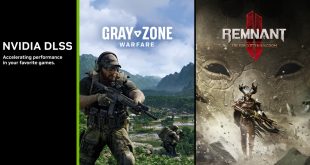It's a great, great time to be a PC gamer. Not only is having a mid-range gaming setup going to cover you against most of the next-gen console developments, but Valve is set to produce its own Steam box system within the next six months using PC hardware – so console developers now have a whole new reason to produce strong ports for the platform. On top of this though, AMD and Nvidia are taking gentlemanly swipes at one another, with big developments in the works that could cause serious ramifications for the industry – and it's all a bonus to us, the consumer.
On one hand, you have AMD making leaps and strides in its game. For a long time it's been the budget Nvidia, the better bang for buck at the mid-range, but rarely competing head to head at the top end of performance: where graphics card firms are often judged. Now though, it's managed to get itself into both big net-gen consoles from Microsoft and Sony and it's announced a new graphics driver API, the Mantle, which could potentially improve some aspects of in-game rendering performance by up to nine times. By giving developers direct access to the graphics memory and core, AMD is bypassing the traditionally quite clunky DirectX API and offering the sort of performance we usually only see coming out of ageing console hardware, since it's easier to develop for.

With draw calls being one of the biggest frame rate bottlenecks, this could prove very interesting
Of course we have yet to see this in action – we'll need to wait for Battlefield 4 to see Mantle go head to head with DX11 – and even when released, you need a Graphics Core Next supporting GPU; so anything from AMD's 7 series onwards, but it's exciting nonetheless, to think that graphics performance could take a big leap if other developers jump onboard the mantle train. If they do, they might end up needing to develop separate versions for both AMD and Nvidia, as well as the Xbox One and PS4. This means it'll likely be utilised – at least at first – by AAA studios only, but it's a start and it'll be noticeable if the performance gains can be replicated in real games.
This isn't good news for Microsoft though, which is already taking a beating thanks to poor Windows 8 sales and in the fact that Gabe Newell seems determined to turn PC gamers into Linux users, both with Valve's SteamOS and his decrying of Windows' burgeoning closed architecture. The loss of popularity for its DirectX API could be catastrophic. If Linux suddenly started offering massive performance gains for PC users, a lot of people would jump ship and not come back.
Nvidia of course isn't sitting silent, but it isn't coming out with big graphical developments of its own either, merely mud slinging for now. Since it didn't manage to get its hardware into either of the net-gen consoles, it won't be touting their benefits like it did with the PS3, which used a GPU core from Nvidia. Instead, its higher ups are regularly stating how poor the Xbox One and PS4 will perform compared to PCs. That's likely to be true, but Nvidia wouldn't be singing this tune if its chips were sitting pretty in the next-gen systems, it'd be telling us instead how the optimisation will mean strong graphical performance on a power budget, instead of suggesting that the aesthetics of the PC just won't translate to console.

A free gaming OS with all my favourite titles? Yes please.
It's also finally extended an olive branch to Linux, an operating system it has previously and continually shunned with development help. Funnily enough, this comes just after Valve made such a push for not only Linux development, but Linux optimised hardware and a whole new generation of small form factor, living room PCs, designed with gaming in mind and running a version of Linux.
Nvidia just realised it's about to be left out in the cold and is scrambling to catch up.
While some of AMD's developments are still somewhat fantasy as we have yet to see them in action – be it next-gen consoles or the new Mantle API – and it would be good for Nvidia to fire back with more than words in order to keep the competition alive, it's going to be an exciting few months as we close out the year. The PC platform is finally getting the recognition it deserves once again and we might finally be moving away from the relatively expensive Windows OS platform. Beyond that we have the best indie development in the industry, with the best platforms to host/sell it on – Steam Greenlight, Humble Bundle, GoG – the most powerful hardware at a price that's becoming more affordable and of course SSDs. No next-gen system will ever, in its lifetime, be able to compete with a PCs load times.
Gaming on the PC is going to be very good over the next few years and the graphics wars could be make it even more exciting.
Kitguru Says: I feel like a band I've been into for a very long time is just starting to hit mainstream, or at least, make a comeback tour after a long hiatus. It does make me feel like I should upgrade by old 5870 for something a bit more impressive though.
 KitGuru KitGuru.net – Tech News | Hardware News | Hardware Reviews | IOS | Mobile | Gaming | Graphics Cards
KitGuru KitGuru.net – Tech News | Hardware News | Hardware Reviews | IOS | Mobile | Gaming | Graphics Cards


